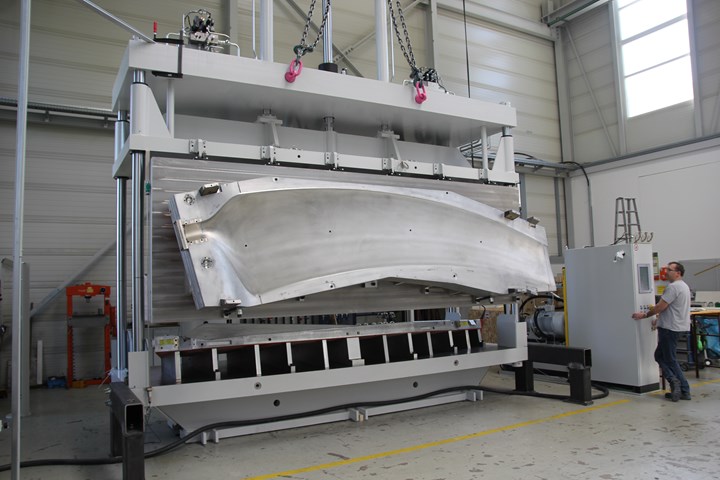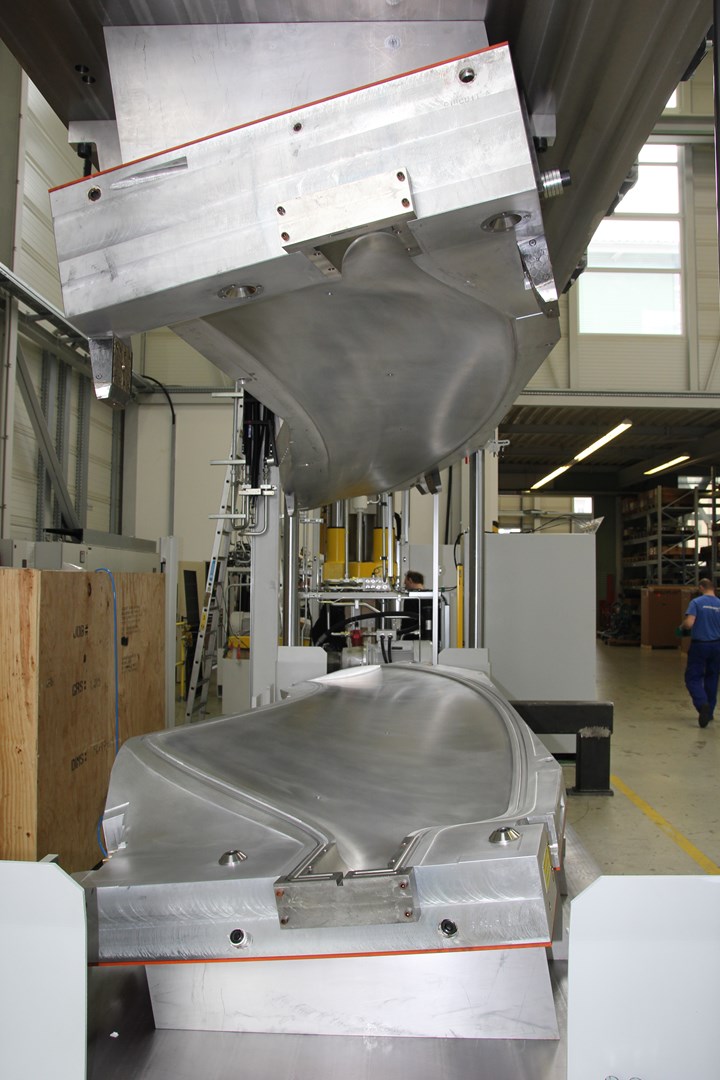Fiberglass industrial fan manufacturer builds on tradition
Collaboration produces large diameter low noise application composite axial flow fan.

Hudson Products turned to Wickert Hydraulic Presses for a press similar to its existing presses, yet with updated controls and a higher degree of functionality and control. Source | Wickert Hydraulic Presses
Hudson Products (Hudson, Beasley, Texas, U.S.) is a leading manufacturer of air-cooled heat exchangers and axial flow fans. The company’s fiberglass Tuf-Lite axial flow fans have been in production for more than 60 years and are preferred for industrial applications. More than 250,000 Tuf-Lite fans are currently in use worldwide.
The Tuf-Lite fan series got its start in 1955 with the Tuf-Lite I, featuring a glass fiber-reinforced composite blade. Since its creation, the fan has gone through a few iterations. The original fan was manufactured as a monolithic one-piece airfoil that was molded as a hollow part. Tuf-Lite II was introduced in 1984 to increase the manufacturability of the fan’s parts. According to Hudson Products operation manager Nick Rizzo, it was challenging to maintain the profile of the original monolithic airfoil and still meet part requirements. A new, two-part design was conceived featuring a blade comprising an airfoil and holder, or neck. The design also saw a change in its center hub. In the Tuf-Lite I design, the monolithic blade’s molded neck fit into a socket in the hub, while in the Tuf-Lite II design,the blade’s cylindrical neck was held in place by two clamp halves sandwiched between a top and bottom hub plate. The Tuf-Lite III was introduced in 2004, reverting to the monolithic blade design but keeping the clamping convention.
Hudson’s Tuf-Lite II and Tuf-Lite III fan designs use a proprietary vinyl ester resin in a resin transfer molding (RTM) manufacturing process. A proprietary leading edge protection system is also embedded, and a UV-resistant coating is applied to the blade exterior. The fans are designed to resist corrosion and to maximize the strength-to-weight ratio. The fan blades incorporate an aerodynamic twist and taper designed to provide even airflow distribution and energy efficiency while also minimizing vibration.
Hudson recognized a need in the marketplace for a large-diameter, low-noise fan and saw an opportunity for yet another iteration of the Tuf-Lite series. For the Tuf-Lite IV, the company employed computational fluid dynamics (CFD) technology for a design that focused on noise reduction and efficient airflow.
“The design concept behind the Tuf-Lite IV was to allow us to put a blade into service that would operate as efficiently as our existing designs, however at a lower operating speed,” explains Rizzo.
The resulting Tuf-Lite IV design is modeled after the Tuf-Lite III, but is about 20% larger. Because of the fan’s increased size, the new design was not compatible with Hudson’s existing manufacturing equipment.
“This is a significantly larger blade than what we’ve molded before in the monolithic style,” says Rizzo. “It has a much wider chord, it is significantly longer and the airfoil shape has a pronounced sweep or curve.”

Hudson Products needed a press capable of handling the 5m x 1m tool that would be needed to mold the Tuf-Lite IV fan blades. Source | Wickert Hydraulic Presses
Hudson needed a press capable of handling the 5-by-1-meter tool required to mold the parts. Hudson’s composites presses were previously developed and built in-house, but for the new fan design the company turned to Wickert Hydraulic Presses (Hebron, Ky., U.S.; Landau, Germany) for a new custom press. In addition to increased size, the new blade design presented several production challenges. These included changes in layup sequence, type of fiberglass, material configuration, number of layers, resin injection points and positioning of vent lines. A new epoxy-based resin system was also considered during the design phase, but over the course of development, Hudson reverted to the vinyl ester it has used in past iterations.
“Several custom options were included to the press that were specific to their molds,” says Tony Ackerman, regional sales engineer for Wickert. “We got together with [Hudson’s] mold vendor and collaborated on the design.”
“We didn’t know exactly how the resin front would flow across the part within the mold cavity,” explains Rizzo. “The point of convergence of that resin front was also a concern. With our existing designs — being an RTM application — the closed mold is vented so as we’re pumping in the resin over the part, air is escaping through the vent lines. Once the part is completely wet, the idea is to have the resin bleed out through the vent lines — so the positioning of those vent lines is very important in the mold tool. We want to put those vent lines at the point of convergence of the resin front as it is flowing over the part.”
Wickert also collaborated with Hudson on the control system for the press to set up the specific sequence, alarm system and integration with resin pump system. The automatic cycle was designed to optimize injection timing and pressure heating and cooling. Because an air bladder is used to create a cavity in the hollow fan blade, Wickert installed air actuation controls to tell the air bladder when to inflate at a specific time in the cycle.
“Our existing machines have a level of automation as part of the manufacturing cycle where the operator is able to initiate a resin injection, wet out cycle, then a heating cycle cure then cool down cycle,” says Rizzo. “[Wickert] gave us a press that accomplished all those requirements — we were able to program an automatic operator cycle that functioned similarly to what our existing presses give us, with updated controls and a higher degree of functionality and control compared with our older machines.”
In addition, Wickert designed the press as a top-acting hydraulic machine, which produces a low working height, making it easily accessible for the operator.
“One of the custom features on the press is an upper heating platen that is able to swivel to present itself to an operator for cleaning and visual inspection,” adds Ackerman.
While the automation for the press is still being finalized and some software adjustments are still being made, Hudson has begun producing the Tuf-Lite IV fans and is shipping units.
“The wider chord width and the swept profile allow the blade to operate with increased efficiency at lower RPM, providing a lower overall noise output,” says Rizzo of the new blades. “Plus, we were able to meet these requirements with significantly fewer blades compared to the existing design.”
Fewer blades mean less material, making the Tuf-Lite IV lighter and less expensive to produce.
Related Content
Plant tour: Albany Engineered Composites, Rochester, N.H., U.S.
Efficient, high-quality, well-controlled composites manufacturing at volume is the mantra for this 3D weaving specialist.
Read MoreTU Munich develops cuboidal conformable tanks using carbon fiber composites for increased hydrogen storage
Flat tank enabling standard platform for BEV and FCEV uses thermoplastic and thermoset composites, overwrapped skeleton design in pursuit of 25% more H2 storage.
Read MorePlant tour: Joby Aviation, Marina, Calif., U.S.
As the advanced air mobility market begins to take shape, market leader Joby Aviation works to industrialize composites manufacturing for its first-generation, composites-intensive, all-electric air taxi.
Read MorePultrusion: The basics
A primer describing what pultrusion is, its advantages and disadvantages, and typical applications.
Read MoreRead Next
VIDEO: High-volume processing for fiberglass components
Cannon Ergos, a company specializing in high-ton presses and equipment for composites fabrication and plastics processing, displayed automotive and industrial components at CAMX 2024.
Read MoreDeveloping bonded composite repair for ships, offshore units
Bureau Veritas and industry partners issue guidelines and pave the way for certification via StrengthBond Offshore project.
Read More“Structured air” TPS safeguards composite structures
Powered by an 85% air/15% pure polyimide aerogel, Blueshift’s novel material system protects structures during transient thermal events from -200°C to beyond 2400°C for rockets, battery boxes and more.
Read More






















